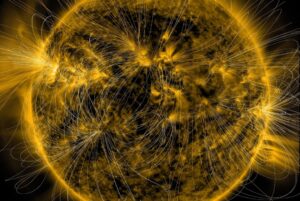New finding addresses a 400-year-old mystery, once explored by Galileo

This illustration lays a depiction of the sun’s magnetic fields over an image captured by NASA’s Solar Dynamics Observatory. Credit: NASA/SDO/AIA/LMSAL
An international team of researchers, including Northwestern University engineers, is getting closer to solving a 400-year-old solar mystery that stumped even famed astronomer Galileo Galilei.
Since first observing the sun’s magnetic activity, astronomers have struggled to pinpoint where the process originates. Now, after running a series of complex calculations on a NASA supercomputer, the researchers discovered the magnetic field is generated about 20,000 miles below the sun’s surface.
The finding contradicts previous theories, which suggest the phenomenon has deep origins — beginning more than 130,000 miles below the sun’s surface.
The research was published on May 22, 2024 in the journal Nature.
Not only does the new discovery help us better understand our sun’s dynamic processes, it also could help scientists more accurately forecast powerful solar storms. Although this month’s strong solar storms released beautiful, extended views of the Northern Lights, similar storms can cause intense destruction — damaging Earth-orbiting satellites, electricity grids and radio communications.
“Understanding the origin of the sun’s magnetic field has been an open question since Galileo and is important for predicting future solar activity, like flares that could hit the Earth,” said study co-author Daniel Lecoanet. “This work proposes a new hypothesis for how the sun’s magnetic field is generated that better matches solar observations, and, we hope, could be used to make better predictions of solar activity.”
An expert in astrophysical fluid dynamics, Lecoanet is an assistant professor of engineering sciences and applied mathematics at Northwestern’s McCormick School of Engineering and a member of the Center for Interdisciplinary Exploration and Research in Astrophysics. Geoffrey Vasil, a mathematics professor at the University of Edinburgh in Scotland, led the study.
Continue to the full Northwestern news article.

